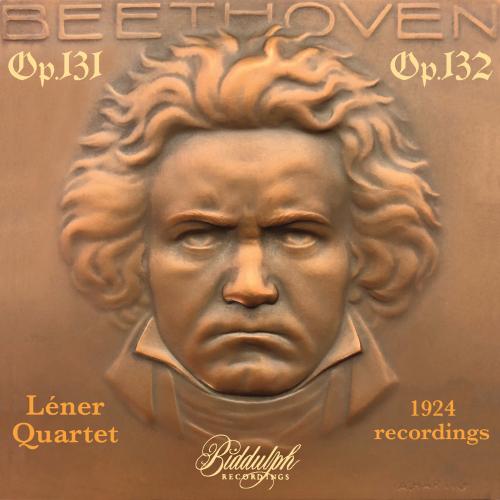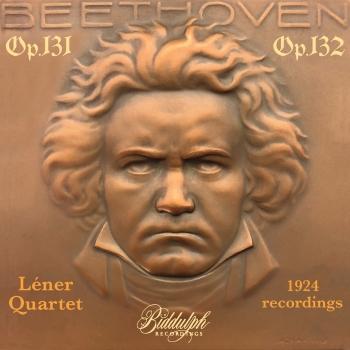
Lener Quartet Play Beethoven Op.131 & Op.132 Lener Quartet
Album Info
Album Veröffentlichung:
2024
HRA-Veröffentlichung:
09.02.2024
Label: Biddulph Recordings
Genre: Classical
Subgenre: Chamber Music
Interpret: Lener Quartet
Komponist: Ludwig van Beethoven (1770-1827)
Das Album enthält Albumcover Booklet (PDF)
- Ludwig van Beethoven (1770 - 1827): String Quartet No.14 in C-sharp minor, Op.131:
- 1 Beethoven: String Quartet No.14 in C-sharp minor, Op.131: I. Adagio ma non troppo e molto espressivo 08:36
- 2 Beethoven: String Quartet No.14 in C-sharp minor, Op.131: II. Allegro molto vivace 03:08
- 3 Beethoven: String Quartet No.14 in C-sharp minor, Op.131: III. Allegro molto - Adagio 00:39
- 4 Beethoven: String Quartet No.14 in C-sharp minor, Op.131,:IV. Andante ma non troppo e molto cantabile - Più mosso - Andante moderato e lusinghiero - Adagio - Allegretto - Adagio, ma non troppo e semplice - Allegretto 14:07
- 5 Beethoven: String Quartet No.14 in C-sharp minor, Op.131: V. Presto 05:45
- 6 Beethoven: String Quartet No.14 in C-sharp minor, Op.131: VI. Adagio quasi un poco andante 02:04
- 7 Beethoven: String Quartet No.14 in C-sharp minor, Op.131: VII. Allegro 06:22
- String Quartet No.15 in A minor, op.132:
- 8 Beethoven: String Quartet No.15 in A minor, op.132: I. Assai sostenuto - Allegro 08:20
- 9 Beethoven: String Quartet No.15 in A minor, op.132: II. Allegro ma non tanto 08:10
- 10 Beethoven: String Quartet No.15 in A minor, op.132: III. Heiliger Dankgesang eines Genesenen an die Gottheit, in der Lydischen Tonart: Molto adagio - Andante 17:30
- 11 Beethoven: String Quartet No.15 in A minor, op.132: IV. Alla marcia, assai vivace 02:04
- 12 Beethoven: String Quartet No.15 in A minor, op.132: V. Allegro appassionato 06:32
Info zu Lener Quartet Play Beethoven Op.131 & Op.132
"Das Léner-Quartett war das erste Ensemble, das alle 16 Streichquartette Beethovens aufnahm. Das aus Budapest, Ungarn, stammende Léner-Quartett, von dem drei Mitglieder Schüler des berühmten Jenő Hubay waren, war vielleicht das herausragende Streichquartett der 1920er Jahre. Nach ihrem erfolgreichen Debüt im Vereinigten Königreich im Jahr 1922 nahm British Columbia das Quartett unter Vertrag. Neben dem Beethoven-Zyklus nahmen sie viele Haydn- und Mozart-Aufnahmen sowie die gesamten Brahms-Quartette auf.
Die beiden späten Beethoven-Quartette auf diesem Album sind in der akustischen Fassung von 1924 enthalten. Obwohl sie im Katalog durch die ein Jahrzehnt später entstandenen elektrischen Aufnahmen verdrängt wurden, halten die meisten Kenner der Kammermusik diese früheren Aufnahmen für überlegen. Darüber hinaus hat ihre Wiedergabe von Beethovens a-Moll-Quartett einen wichtigen literarischen Bezug, da es im letzten Kapitel von Aldous Huxleys Roman Punkt-Gegen-Punkt von 1928 zu einem zentralen Bild wird. Die bewegende Beschreibung des Heiligen Dankgesangs und seiner Wirkung auf die Hauptfigur Spandrell in den letzten Minuten seines Lebens ist ein Tribut an die Intensität der Aufführung."
Léner Quartet
Digitally remastered
The Léner String Quartet
sometimes written the Lehner String Quartet, was a string quartet of Hungarian origin, founded in Budapest in 1918, which for most of its pre-war career operated in or from London. They appeared at the Royal Albert Hall, London on three occasions between 1922 and 1926. They also performed in New York, Amsterdam, and elsewhere in Europe. The Léner made the first complete recorded cycle of Beethoven quartets.
Jenö Léner was born at Szabadka, Hungary (later annexed to Yugoslavia), on 24 June 1894. He studied at the Royal High School for Music in Budapest. He founded the quartet in 1918 and was its leader.
The Léner Quartet recorded extensively during the 1920s and 1930s for Columbia Records, a partnership which received a strong impetus from the centenary of Beethoven's death in 1927, when a core of the Beethoven quartets were recorded or begun (L series). This was followed up in 1928 with the Schubert centenary, for which the Léner recorded the Octet. The LX prefix records below were mainly issued between 1933 and 1936.
The Léner Quartet were among several groups to arise from the Budapest Opera Orchestra after the Great War. All born in 1894-95, the players had a particularly uniform style: three were pupils of Jenő Hubay and the cellist was a Carl Popper disciple. Jenő Léner, the prodigy of Hubay’s class, had played in the first violins of the Budapest Philharmonic at 11; József Smilovits had won the Reményi Prize; Sándor Róth had appeared as a soloist and was already teaching at the Academy; and Imre Hartman, who had won the Popper Prize, anchored the group with firm rhythm and a tone of depth and penetration. Their ensemble was Leó Weiner’s first success as a chamber music coach.
The 1918 revolution was their cue to leave the orchestra and retire to the country with a trunkful of scores, to work on repertoire. In 1919 they made their Budapest début and in 1920 gave a Vienna recital attended by prominent musicians including Ravel. He coached them and urged them to play in Paris, which they did the next autumn, causing a sensation. In 1922 they toured Italy and played six times at Wigmore Hall, London.
Their pianist, on almost every occasion in their career, was Florence-based Olga Loeser-Lebert (1887–1942, née Lebert Kaufmann), pupil of Max Pauer, grand-daughter of the composer and teacher Sigmund Lebert and wife since 1914 of the American art critic and collector Charles A. Loeser. The Léners were regularly able to stay and rehearse at the Loesers’ home, the Villa Torri Gattaia, and the couple’s friends were often invited to hear them play. ‘Carlo’ Loeser bought a Stradivari violin for Jenő Lener and subsidised the quartet in other ways. Even after his death in 1928, Olga Loeser-Lebert kept up her close friendship and working relationship with the quartet.
London became a home from home for the Léners: they were quickly snapped up by the Columbia Graphophone Company Limited, who had developed a new shellac compound, marketing their products as ‘Columbia New Process Records – the ONLY Records without Scratch’. From 13 November 1922 the Léners were fixtures in the Columbia studios, although some early electrics were made at Wigmore Hall. The group’s records did so well that in 1935 they were presented with a Gold Disc.
Forays to North America in 1929-31 were successful artistically but not financially, so the Léners consolidated their European career. They especially liked to present series of recitals illustrating the development of the string quartet. The outbreak of war in 1939 found them touring South America and in 1941 three of them decided to settle in Mexico City. Jenő Léner, however, was set on continuing and, to the others’ dismay, abandoned them. By 1942 he was in New York with new colleagues, but this ensemble was plagued by personnel changes. After the war he returned to Europe, insisting on hiring Weiner pupils to keep the style consistent. In 1948 the group visited South America for three months, giving Beethoven cycles in Buenos Aires, Rio de Janeiro and São Paolo. However, Léner’s death from cancer in New York on 4 November brought an end to an illustrious ensemble.
Booklet für Lener Quartet Play Beethoven Op.131 & Op.132









